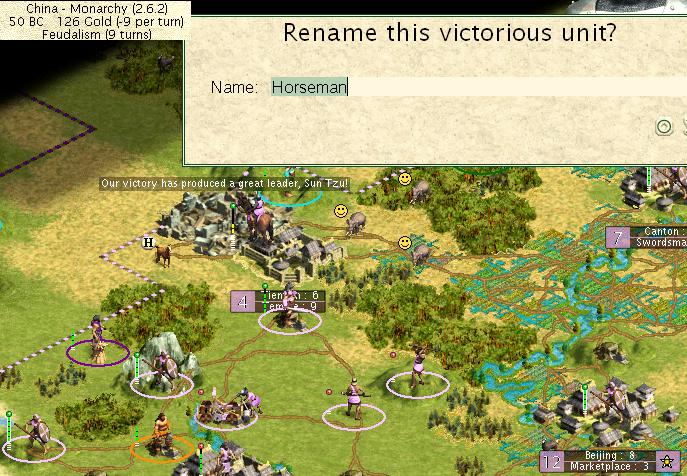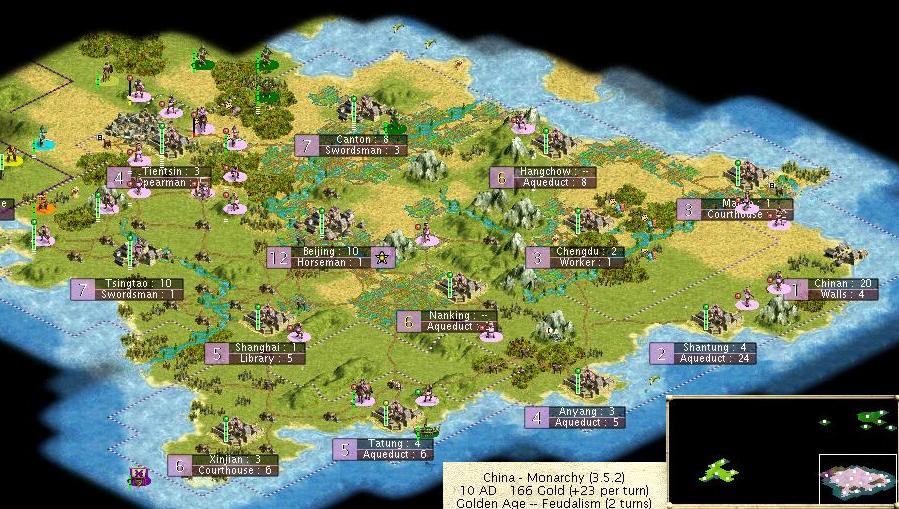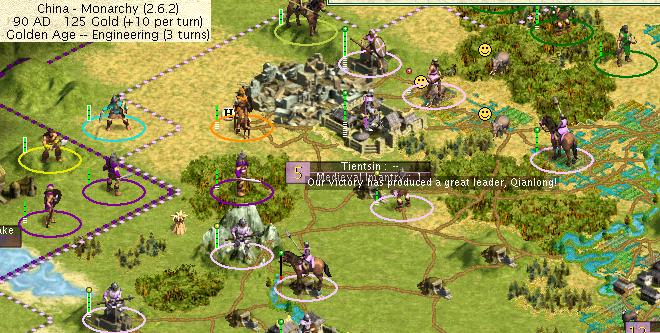

A number of interesting things were going on right around the 250BC mark in my game. I'll start by posting a map of how my civ looked at the time:
This image has been lost.
I'll start by pointing out the dramatically increased enemy presence compared to previous screenshots. There are two American swords, four Mongol archers, and a Persian archer plus an Iroquois spear moving into my territory. And this was a picture taken at the end of my turn, after I had already killed the units in my borders. The AI civs had definitely stepped it up, and holding my lines was getting to be a real issue. Next take a look at what I'm researching; Monarchy is due next turn and I plan to revolt immediately upon discovery. Getting out of despotism would be a major step forward for my civ, and open up the ability to cash-rush units or buildings in a pinch. Be aware also of the fact that I've nearly finished filling in the backland territory of my subcontinent, with just two more cities yet to be founded. Those cities back there would take a long time to be productive, but would be immensely helpful to my efforts over the long haul. Finally, I also have my Forbidden Palace set to complete in just three more turns. Getting a FP up in BC years is just such an immense boost, I can't overstate its importance. The combination of Monarchy + FP was to dramatically reduce corruption across my little civ when they both came online a few turns later.
As expected, I discovered Monarchy on the next turn and revolted, drawing a friendly 3-turn anarchy. The turn after that (210BC), the Americans cascaded to and built the Great Library. Well there goes my chances of getting that wonder; it would have been nice, but I can't say I really needed it. The early discovery of Literature was responsible for keeping that one alive in the cascade; since I had only gotten one leader to that point, I had definitely made the right choice to take the Pyramids over the Library. Of course other players who got more early leaders may have jumped ahead of me on this issue, but there's nothing I could have done about that.
The Chinese Monarchy was formed in 170BC, with Mao assuming the Mandate of Heaven and the Celestial Throne. A few turns after that, the Forbidden Palace was constructed in Nanking, and all of a sudden my shield production had increased dramatically across the board. 110BC is a good date for a hand-built Forbidden Palace in my eyes. I noted that I killed my first Egyptian units in 190BC, and my first Japanese ones in 110BC. The first Japanese unit to die put up quite a fight before falling though, with a 2hp spear killing an elite sword before going down. I hope that that's not a premonition of things to come... The first Ottoman units showed up in 70BC to be killed; though I didn't know it at the time, this was due to the fact that they had the furthest distance to come meet me. I discovered Construction next and entered the Middle Ages in 70BC, not pulling a free tech of course since China isn't Scientific. Research went into Feudalism at max right away - can anyone say Medieval Infantry? The turn after that, a valiant horseman bravely charged out against the enemy...

...and returned back as the mighty hero Sir Sun Tzu! Remember this unit, he's going to figure prominently into the story later. Now there remained the question of what to use my second leader on. I initially thought to use him for Sun Tzu's, but Feudalism was still several turns away and I was pretty sure I could get another leader before the AI civs built up 600 shields. Looking at the list of available wonders, one of them immediately jumped out at me: the Great Wall! While the big wall is less than useful in most games, here in an Always War context it was enormously beneficial. With the Great Wall, any city walls I built would provide a full 100% defensive bonus to the units inside, just as good as a size 13+ city. And, playing as the Chinese here, could I really pass on the chance to build the Great Wall? It was an easy decision to make, and I rushed it in Tientsin - again to get a free cultural border expansion.
On the next turn, the combination of the Pyramids and the Great Wall sent me into an early golden age. Umm, as I had known it would, yeah. I should pay a little bit closer attention to what wonders I build in the future. This was actually a well-timed golden age, as I had already gotten into Monarchy and could use the shield bonuses to crank out badly-needed infrastructure in my new backline cities. Meanwhile, my 3-4 old cities would try to hold the line by themselves against the AI civs. Beijing hit 31 shields/turn in the Golden Age and was able to crank a horseman every single turn, which proved to be enormously helpful, as I would build swords/MDIs closer to the front. A word about combined arms here: at this stage in the game, I had to use a combination of swords, horses, and catapults to keep my losses down. You really have to use them in tandem to keep up with the fact that you are so badly outnumbered. First I would examine the front to see what units to use where that turn, under the main operating principle of "what can wait, should wait." Then cats moved and fired first, hopefully doing some important damage. After the cats went, I would then re-examine the situation, and decide where to attack with units. Swords attacked where they would not be exposed to counterattack in turn from the AI civs, horses would attack in a situation where they needed to attack and then move a second time. And of course you have to factor in workers to this equasion too, who can lay down the all-important roads and fortresses. All in all, each turn was like a puzzle waiting to be solved; it makes the turns take a very long time, but is certainly entertaining to play out!
By 10AD when the years changed over, I was in a dicey situation. I was hoping I had expanded fast enough to handle all the AI units, and fearing that I had not. I was just barely keeping the AI civs back even with golden age production; what was going to happen when that wore off? I didn't know, but things were certainly touch-and-go at this stage. Here's the map from that date:

The AI civs were plainly coming in larger and larger numbers now, and I was holding them back with just a handful of units. Meanwhile, only four of my cities were working on military as the rest were on city improvements. If things really started to go badly I would have pulled them off of infrastructure, but I knew that I had to get them up to speed or I would be hurting down the road. That's the trick of winning in Always War, knowing when and how to swap cities off of military and onto other things. So while things looked bleak at this point, I knew that this would only benefit me in the future. My plan was simply to hold the line for now and push forward when my cities finished their current projects - which would also coincide with the discovery of Chivalry and Riders.
I discovered Feudalism in 50AD and could upgrade my swords to MDIs. While doing this, I noticed something interesting: upgrading a unit restored it to full hit points in the process! This sounds trivial, but it actually helped me a great deal by allowing me to get MDIs back into the field a turn sooner without having to wait for healing. I'll remember that for the future as well. The next good thing to happen was another leader popping up in 90AD!

That horse won with only 1hp left; if I had rolled a slightly different result, I get a dead horse and no leader. Funny how the RNG turns out sometimes... Also take a look at how busy that front is! I've got a lot on my hands, that's for sure. I'll also point out how I have pikes occupying the high ground on mountains and hills; those who failed to do so will have had a terrible time trying to dislodge enemies who camped out up there. There was no question on what to use this leader on; Sun Tzu's was calling out to me. There is NO better wonder on a pangea map for this sort of game than Sun Tzu's, the free healing everywhere in all cities is an amazing benefit. I would have really been in trouble if I had missed out on that one!
The next few turns continued to be dicey, with my units just barely holding the lines against the AI attackers. Take a look at that picture above and imagine that same sitation every single turn; you'll get the idea. With all those units flooding my territory, I suppose I shouldn't have been surprised to get another leader (#4) in 190AD:
This image has been lost.
I used this leader on the last remaining wonder, the Hanging Gardens, which provided some much-needed happiness for my civ. I also noted on this turn that I was so short on attackers that three pikes had to attack and finish off AI archers. That's when you know that you're short on units. As bad as things seemed to be going, by 250AD I had the front relatively stable and under control. This was due in part to an increased number of catapults I had brought up to the lines, but also to the greater number of roads I had up by the front. It seemed as though I had survived the first wave of AI attacks, and with Riders due to appear within the next 10 turns, it would soon be time for my first cautious push forward against the enemy civs. And this also begs a burning question that had yet to be answered: where on earth was Gandhi?!
| China | Iroquois | America | Persia | Mongolia | Japan | Ottomans | Egypt | Total AI Civs | 750BC | 7 | 17 | 2 | 0 | 0 | 0 | 0 | 0 | 19 |
|---|---|---|---|---|---|---|---|---|---|
| 250BC | 10 | 20 | 11 | 5 | 1 | 0 | 0 | 0 | 37 |
| 250AD | 28 | 44 | 26 | 15 | 20 | 12 | 14 | 7 | 138 |
I think the one thing to observe here is the massive increase in AI units; I saw only 18 units in the 25 turns from 750BC to 250BC, and then a massive 101 units in the 25 turns from 250BC to 250AD. That's a pretty significant increase (about 6 times as many). The fact that I only lost 18 units to kill 101 AI units speaks pretty highly of the effectiveness of combined arms. Players who did not conserve their units, pay close attention to terrain, and make heavy use of catapult support are likely to have experienced major problems here. It was a good thing that I was in a golden age!






